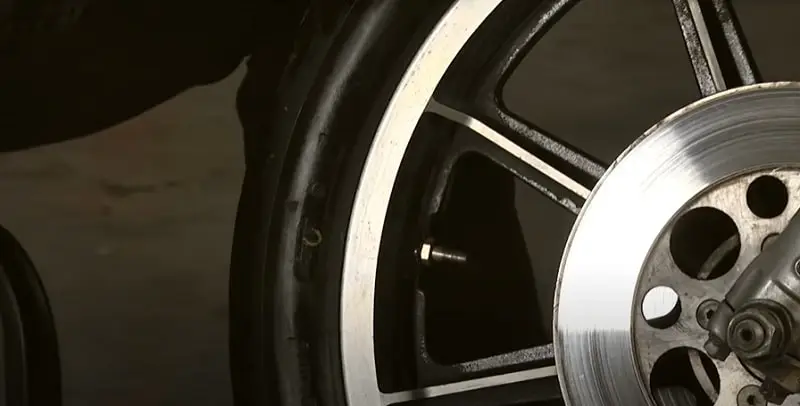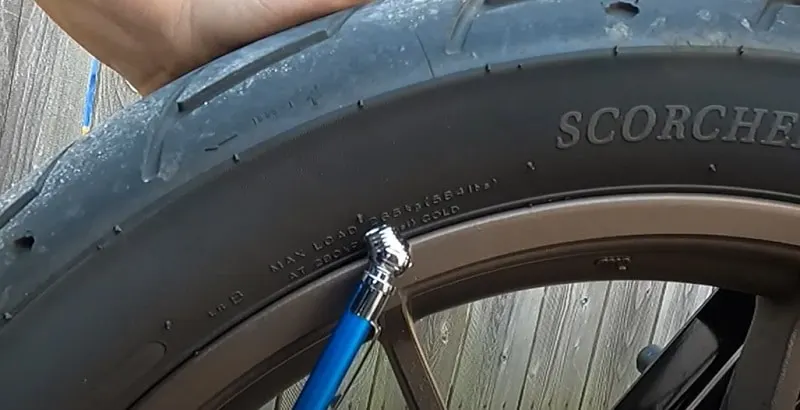Maintaining proper tire pressure on your motorcycle is essential for a safe and smooth ride. But what happens if your tire pressure is too high?
If the tire pressure of a motorcycle is too high, it can cause instability and increase the risk of a blowout. It can also lead to worn-out center treads, internal structural damage to the tire, poor handling, and premature tire wear. High tire pressure can cause motorcycle riders problems, including a harder, less comfortable ride, poor handling, and premature tire wear.
This article will explore the consequences of high tire pressure on your motorcycle and how to properly check and adjust your tire pressure to avoid these issues.
Maintaining proper tire pressure ensures your motorcycle runs at its best and keeps you safe on the road.

The Consequences of High Tire Pressure
High tire pressure can lead to several negative consequences for motorcycle riders. A harder, less comfortable ride is one of the most immediate effects of high tire pressure.
This is because the tire is more rigid and has less contact with the road, resulting in a rougher, bumpier ride.
High tire pressure can also affect the motorcycle’s handling, making it more difficult to control and potentially dangerous in certain situations.
For example, overinflated tires can make the motorcycle more prone to skidding and sliding and cause the bike to feel unstable or “light” on the road.
In addition to the negative effects on ride comfort and handling, high tire pressure can lead to premature tire wear.
This is because the tires are under more stress and are subject to more wear and tear due to increased rigidity. As a result, the tires may only last for a short time as they would with proper tire pressure.
Overall, it’s important to maintain proper tire pressure on your motorcycle to ensure a safe and enjoyable ride and extend your tires’ lifespan.
How to Check and Adjust Tire Pressure
To check the tire pressure on your motorcycle, you will need a tire pressure gauge. This small, handheld tool measures the tire’s air pressure.
Several types of tire pressure gauges are available, including dial, digital, and stick-style gauges. It’s important to use a reliable and accurate tire pressure gauge to get an accurate reading.
To check the tire pressure, follow these steps:
Locate the tire valve on your motorcycle’s tire. This is a small, round valve located on the tire’s sidewall.
- Remove the cap from the valve.
- Press the tire pressure gauge onto the valve and hold it in place for a few seconds.
- Read the tire pressure on the gauge. The tire pressure should be within the recommended range for your specific make and model of motorcycle.
This information can typically be found in the owner’s manual or the manufacturer’s website.
If the tire pressure is too low, you will need to add air to the tire. To do this, you will need an air compressor or a hand pump.
Attach the compressor or pump to the tire valve and inflate the tire to the recommended pressure.
If the tire pressure is too high, you will need to release some air from the tire. To do this, press the tire pressure gauge onto the valve and hold it in place until you hear the air escaping. Then, release air until the pressure is within the recommended range.
It’s important to check the tire pressure regularly, at least once a month, and before long trips. This will help ensure that your motorcycle is running at its best and that your tires are in good condition.
Tips for Maintaining Proper Tire Pressure

Here are some tips for maintaining proper tire pressure on your motorcycle:
Check the tire pressure regularly: It’s a good idea to check the tire pressure at least once a month or more frequently if you ride your motorcycle frequently.
This will help ensure that your tires are properly inflated and that your motorcycle runs at its best.
Use a reliable tire pressure gauge:
Make sure to use a reliable and accurate tire pressure gauge to get an accurate reading.
Several types of tire pressure gauges are available, including dial, digital, and stick-style gauges. Choose a gauge that is easy to use and provides accurate readings.
Follow the manufacturer’s recommendations:
It’s important to follow the manufacturer’s recommended tire pressure for your specific make and model of motorcycle.
This information can typically be found in the owner’s manual or the manufacturer’s website.
Refrain from overinflating or underinflating the tires: Overinflating or underinflated tires can lead to various problems, including poor handling and premature tire wear.
Instead, inflate the tires to the recommended pressure to ensure a safe and smooth ride.
Consider the load and riding conditions:
The recommended tire pressure may vary depending on the load and riding conditions.
For example, if you are carrying a heavy load or riding in particularly hot or cold conditions, you may need to adjust the tire pressure accordingly.
By following these tips, you can help ensure that your motorcycle tires are properly inflated and that your motorcycle is running at its best.
This will help you enjoy a safe and comfortable ride and extend your tires’ lifespan.
Frequently Asked Questions
Here are some frequently asked questions about motorcycle tire pressure:
How often should I check my motorcycle tire pressure?
It’s a good idea to check the tire pressure on your motorcycle at least once a month or more frequently if you ride your motorcycle frequently. It’s also a good idea to check the tire pressure before long trips.
What happens if my motorcycle tire pressure is too low?
If the tire pressure on your motorcycle is too low, it can cause various problems. For example, the motorcycle may handle poorly and be more prone to skidding and sliding.
Low tire pressure can also lead to premature tire wear and shorter lifespan. Therefore, it’s important to maintain proper tire pressure to ensure a safe and comfortable ride and extend your tires’ lifespan.
Can I overinflate my motorcycle tires?
Yes, it is possible to overinflate your motorcycle tires. Overinflated tires can lead to a harder, less comfortable ride, poor handling, and premature tire wear.
Therefore, it’s important to maintain proper tire pressure and avoid overinflating the tires.
Does Rider Weight Affect Tire Pressure?
Yes, rider weight can affect tire pressure on a motorcycle. The rider’s weight and any additional load being carried can put additional stress on the tires and may require a higher tire pressure to support the load.
Therefore, the recommended tire pressure for a motorcycle may vary depending on the rider’s weight and any additional load being carried.
For example, if you are a heavier rider or are carrying a heavy load on your motorcycle, you may need to inflate the tires to a higher pressure to support the additional weight.
On the other hand, if you are a lighter rider or are carrying a lighter load, you can use a lower tire pressure.
It’s important to follow the manufacturer’s recommended tire pressure for your specific make and model of motorcycle, taking into account the rider’s weight and any additional load being carried.
This will help ensure a safe and comfortable ride and extend the lifespan of your tires.
In Conclusion
Maintaining proper tire pressure on your motorcycle is important to ensure a safe and enjoyable ride.
However, high tire pressure can lead to a harder, less comfortable ride, poor handling, and premature tire wear.
To avoid these problems, regularly check and adjust the tire pressure on your motorcycle. Use a reliable tire pressure gauge and follow the manufacturer’s recommended tire pressure for your specific make and model of motorcycle.
Maintaining proper tire pressure can help ensure your motorcycle runs at its best and keep you safe on the road.
Previous Article: What Causes Motorcycle Tires to Wear Out Prematurely?
Next Article: Which Type Of Motorcycle Tire Wears Out Fastest?